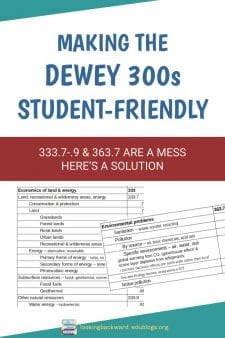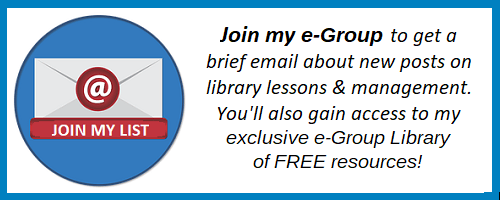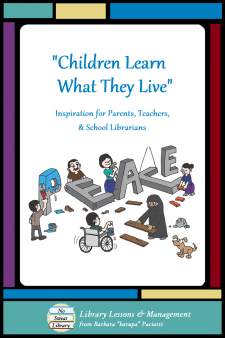 If your school library collection is like mine, the 300 Social Sciences takes up large part of your Dewey area. What boggles the minds of students, teachers, and School Librarians alike is the mish-mash of disparate topics with an arrangement that doesn’t make much sense. Plus, the 300s seem to have many books that belong in other Dewey sections!
If your school library collection is like mine, the 300 Social Sciences takes up large part of your Dewey area. What boggles the minds of students, teachers, and School Librarians alike is the mish-mash of disparate topics with an arrangement that doesn’t make much sense. Plus, the 300s seem to have many books that belong in other Dewey sections!
As a lover of the Dewey Decimal Classification system and a college major in the Social Sciences, I hope to help you understand this Dewey Class…and suggest some changes that might better serve your students and teachers.
THE METHOD OF ASSIGNING DEWEY NUMBERS
Remember that Dewey Decimal Numbers are assigned by discipline, that is, the field of study—the profession. How does that differ from subject?
- Subject asks, “What is this about?” and is the topic of a book—the informational content inside.
- Discipline asks, “Who is this for?”—who will use this—and assigns a Dewey number so those folks find their professional information in one place.
A particular subject, then, can be assigned more than one Dewey number depending on which profession uses the material for their own purposes. Here’s a DDC example of a simple water report that can apply to 5 different Dewey numbers:
Use 333.91 for monitoring to protect water quality, 553.7 for chemical & biological status, 363.6 for assuring compliance with standards, 628.1 for technical aspects of water treatment, and 628.93 for effectiveness of sewage treatment. (Abridged 15, p65.) [edited for brevity]
Also keep in mind that books for more than one discipline or subject are assigned the lowest Dewey Decimal number that includes all disciplines—using the rule of two or the rule of three. This explains why the 300 section is so large: its numbers are lower than 6 other Dewey Classes, so multiple subject/discipline books are placed in the 300s rather than where we might need them for our school curriculum.
Visit my blog posts on Dewey 590s Animals for more about disciplinary alignment, and Let’s Put Dewey Decimal Books Where Students Can Find Them for more on the rules of two & three.
WHAT DOES 300 SOCIAL SCIENCE REALLY INCLUDE?
Calling the 300s “social sciences” may be a slight misnomer: the social sciences include geography and history which Dewey places in the 900s, as well as psychology which Dewey places in the 100s. Thus, of the 7 social sciences, only sociology, anthropology, political science, and economics are in the 300s.
Since these four disciplines are about social relationships and the organization & function of human societies, I’ve chosen a more specific name for this Dewey number which students understand better than the generic “Social Sciences”:
Dewey 300 – Society, Government, and Culture
Unfortunately, the materials for these 3 broad headings are not necessarily in contiguous divisions and sections, so here’s the 300 divisions each one encompasses:
- Society: 300 Sociology & anthropology and 360 Social problems & services
linebreak
- Government: 320 Political science, 330 Economics, 340 Law, and 350 Public administration & military science, and 380 Commerce, communications & transportation
linebreak
- Culture: 370 Education & 390 Customs
NOTE: You probably won’t have any 310s in your school library because it’s just for statistical records.
SOCIETY
300 Sociology & anthropology
The 300s begin with society, specifically sociology & anthropology. If we consider psychology (the 100s) as the social science of the individual, then 300-307 is the social science of groups. It includes behaviors like bullying, gangs, prejudice & discrimination; interactions such as social change & civil disobedience; and relationships between individuals, groups, and communities. It does have one section important for School Librarians:
- 305 Groups of people introduces those used throughout the rest of the 300s by age, gender, social class, race, ethnicity/ancestry, occupation, and illness/disability. School Librarians need to build this section with high-quality, equity-sensitive resources because it can so strongly influence the minds of our students.
360 Social problems & services
This division may be, I suspect, the one that gives School Librarians the most headaches. It’s categorized according to type of problem and how the service is provided:
- for specific groups of people (according to the groups in 305),
- as governmental services such as public safety, crime & punishment,
- by public & private societies & clubs,
- by commercial insurance services,
- by associations.
Some books in this division are victims of the rules of two or three, such as substance abuse and mental & physical disorders. I relocated many of these to appropriate higher numbers for better student access.
363 Other social problems and services
If the 360s are problematic, this section is particularly exasperating for School Librarians. Like any “other” section of the 300s, it’s a dumping ground for disparate topics. To understand what’s covered in this section, think of it as the basic needs of Maslow’s Hierarchy: physical needs for human survival, and our need for safety & security.
- 363 begins with Public safety from hazards, followed by police services with crime investigation & forensics, and ‘safety’ from moral ‘problems’, like alcohol, gambling, prostitution, pornography, homosexuality, drug trafficking, and abortion. The public safety portion ends with another dumping ground—363.3 Other aspects of public safety which has just about everything else, from censorship to terrorism to gun control to firefighting.
linebreak
363.34 Disasters is actually disaster relief, and school libraries may have sizeable sections here on earthquakes & volcanos, floods & tsunamis, and other earth & weather-related disasters. I relocated many of these to 551 Earth science so they’d be together for science class assignments.
linebreak
- 363 ends with physical needs and the services that provide for it. This section includes housing, public utilities like water treatment, food supply issues including malnutrition of the poor & famine, and population issues like family planning & birth control, sterilization, and over-population.
linebreak
363.7 Environmental problems is another perplexing spot, because so many popular school topics about environmental protection are crammed in here. I added additional numbers (below) to better define the different topics:
| Description |
Dewey number |
| Environmental problems |
363.7 |
| Sanitation – waste control, recycling |
.72 |
| Pollution |
.73 |
| By source – oil, toxic chemicals, acid rain |
.738 |
Of specific environments – air, water, soil
Global warming from CO2 (greenhouse effect) &
ozone layer depletion (You may find ozone books in .738 due to the rule of 2 regarding refrigerants, but I moved mine here because it’s a global issue of the atmosphere. |
.739 |
| Noise pollution |
.74 |
GOVERNMENT
It’s no surprise that 320 Political science, 340 Law, and 350 Public administration & military science align with the 3 branches of U.S. government. (Be aware that other countries may not have this structure, but most of those books are in the 900 section. )
- 320 Political science includes civil & human rights, the political process & elections, relations between nations, and the legislative process, hence, books about the U.S. Congress.
- 340 Law covers international, constitutional, regional/state, economic, criminal, and civil law, and includes the United Nations, the U.S. Constitution & Bill of Rights, and the U.S. Supreme Court.
- 350 Public administration covers the executive branch—the U.S. Presidency, the Cabinet, and management of departments or agencies such as national security, justice, foreign affairs, health & education, and those with economic or environmental oversight. 355-359 military science covers all branches of the military, which is administered by the head of state.
MAKING THE 300’S MORE STUDENT-FRIENDLY
330 Economics
Economics is probably nestled between 320 and 340, because legislatures (320) set taxes and budgets. This division also includes careers, money, banking, credit cards, the stock market, and taxes. (You may also see books on socialism & communism because they are economic-based systems, but I prefer all books on types of government together, so I relocated mine to 321.)
School Librarians need to know that 330 also covers economic development and management including that of natural resources, so that’s why we find a sizable group of books in 333.7-333.9. I actually added decimals to my books to differentiate between the different topics, according to the table below:
| Description |
Dewey number |
| Economics of land & energy |
333 |
| Land, recreational & wilderness areas, energy |
333.7 |
| Conservation & protection |
.72 |
| Land |
.73 |
| Grasslands |
.74 |
| Forest lands |
.75 |
| Rural lands |
.76 |
| Urban lands |
.77 |
| Recreational & wilderness areas |
.78 |
| Energy – alternative, renewable |
.79 |
| Primary forms of energy – solar, nuclear |
.792 |
| Secondary forms of energy – renewable |
.793 |
| Photovoltaic energy |
.796 |
| Subsurface resources – nonrenewable |
333.8 |
| Fossil fuels |
.82 |
| Geothermal |
.88 |
| Other natural resources |
333.9 |
| Water energy – hydroelectric |
.91 |
| Wind energy |
.92 |
| Biofuels, biodiversity, wildlife refuges |
.95 |
380 COMMERCE, COMMUNICATIONS, TRANSPORTATION
This division may seem redundant with topics in 330 Economics; however, this division is for regulatory aspects (law & public administration) and public consumption—the socio-cultural perspective of ‘products’ & ‘people’, that is, services that sustain or benefit our way of life. Here we find:
- domestic & international trade
- the infrastructure for communications—postal, telegraph, computer, wireless (radio, television, satellite), and telephone
- the infrastructure for transportation, including railroads, waterways, air traffic, roads, local mass transit, and pipeline transport of utilities.
You may see here books that are topical with those in the 600s, and they may get increased circulation by relocating them there.
CULTURE
Near the end of the 300s we find the two divisions relating to culture and it’s institutions.
370 Education
Education is how our culture and traditions are passed down from adults to children. Most books with this division number will be about teaching, so will be shelved in our Professional collection. You may, however, want to do as I did, and build a circulating group of books on schools for the historical time periods our students study in their social studies classes, and books on study skills topics.
390 Customs, etiquette, folklore
This is the division we probably think of when we refer to “culture”. It differs from 300 Sociology & anthropology in that 300 is about groups & institutions, whereas this division is about our personal or informal way of life. We find here sections on personal adornment such as clothing & accessories, cosmetics, jewelry, and body alteration like tattoos and body piercing.
We also find sections on customs for home & family life, death, and special occasions, like marriage, festivals, birthdays, and holidays. Interestingly, it’s also where we find such arcane topics as cannibalism and taboos. The topics may seem similar to 306 Culture and institutions, but 306 is about behaviors and interactions, whereas these sections are for specific celebratory rituals.
- 398 Folklore, especially 398.2 Folk literature can be a sizable section in school libraries, and if yours is not well organized, you might want to read my post Let’s Put Dewey Decimal Books Where Students Can Find Them. I offer alternate numbers to group these books according to how our students study folklore.
linebreak
At 398.8 Rhymes and rhyming games we find Mother Goose and other nursery rhymes, as well as lullabies and jump rope rhymes. If your school library serves PreK, you may want to build this section and relocate related books from other areas to make it easier for you and your teachers to find them all together.
WHEN THE 300’s ISN’T THE RIGHT PLACE
 Many School Librarians get frustrated with the Dewey Decimal Classification system and want to “genrify” it like we do our fiction literature. I believe this is because they don’t understand the purpose of DDC:
Many School Librarians get frustrated with the Dewey Decimal Classification system and want to “genrify” it like we do our fiction literature. I believe this is because they don’t understand the purpose of DDC:
“works that are used together to be found together.”
It’s that purpose of DDC which gives us the freedom to change a Dewey number. Since our disciplinary use is different than career professionals, we can locate books where they will better serve the needs of our school curriculum.
For example, one DDC rule of two/three victim is U.S. slavery before the Civil War. Books on this subject can be found at 2 places in the 300s:
- 306.3 Culture/economic institutions if the content is slavery as an established socio-economic culture of the time.
- 326 Slavery and emancipation if the content is about abolitionism and antislavery movements, the political issues of that time period.
I didn’t like either location, so I changed all these books to a little-used but legitimate DDC number where students would find the books within the historical time period:
973.71 Civil War – Social, political, economic history
This number already includes the Underground Railroad and the Emancipation Proclamation, so now all U.S. slavery books are together. After relocating the books, students easily discovered them there and even thought I’d bought new ones!
So, School Librarians don’t have to give up Dewey for radical organizational changes to make their school library more student-friendly. For additional creative ways to use DDC, get my new E-book How to Make Dewey Decimals Student-Friendly found at No Sweat Library, my Teachers Pay Teachers store.


 For decades a light-catcher with this poem hung in my kitchen window to remind me every single day how important a job it is to raise children.
For decades a light-catcher with this poem hung in my kitchen window to remind me every single day how important a job it is to raise children.



